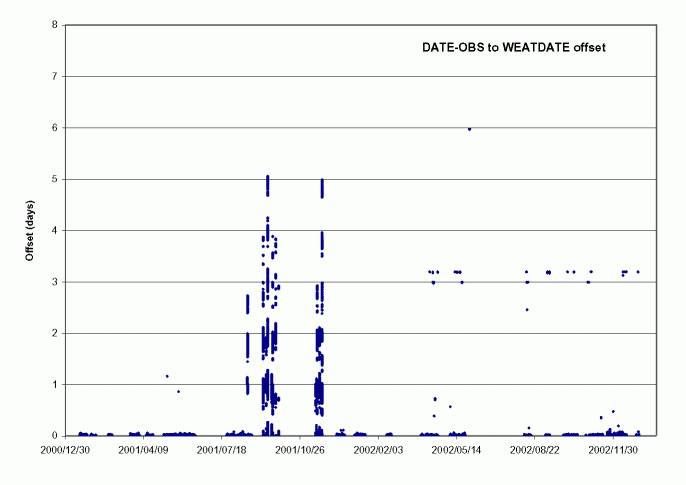Problems with Absolute timing
2003 03 10: Problems with absolute timing of Mosaic exposures
There exist unresolved problems with the absolute timing of Mosaic exposures. For most programs, these are not likely to present serious problems but observers should be aware of the following.
Background
There are a number of FITS header keywords relevant to Mosaic exposure timing. Among them are:
DATE-OBS - this is the UT time and date of the beginning of the exposure as derived from the Arcon detector controller. Arcon timing is derived from the host computer at boot time.
LSTHDR - this is the local sidereal time as acquired from the telescope control system at a time near to the beginning of the exposure. The telescope's LST is derived from a GPS system sited in the 1.5-m dome and is believed to be well-behaved.
The majority of other Mosaic header time values are derived from DATE-OBS by calculation.
Symptoms
The free-running Arcon clock appears to suffer from glitches and drifts:
The glitches result in discontinuous changes in the Arcon timing of amplitudes of several days. These tend to be obvious to the observer and will impact automated data reduction procedures which are sensitive to DATE-OBS. Their cause has not yet been identified.
Unfortunately, the Arcon internal clock is inadequate for precision timing on its own. Drifts of several seconds over the course of a night may be observed.
The cure
Arcon timing is reset at boot time, so drifts and glitches can be corrected by rebooting the system. It is advised that this be done at the beginning of each night anyway.
The offset between LSTHDR and DATE-OBS can be calibrated by an exposure taken immediately after a reboot. Compromised data can be repaired by back-calculating UT from LSTHDR and applying this offset.
This procedure should result in a precision of better than 1 sec.
More details
The graph below shows the difference between DATE-OBS and the keyword WEATDATE. WEATDATE is derived from the weather station and provides an additional comparison, although it should not be used as any form of timing reference. The large excursions near October 2001 should be ignored, but the points around 3 days offset in 2002 illustrate the large timing glitches. (The offsets are all plotted as if positive, but many are negative.)
The graph below shows the timing drifts as sideral seconds in the 2001 and 2002 calendar years.
Finally, this chart shows a three week period with the offsets color-coded by type.
Updated on June 4, 2021, 10:19 am


